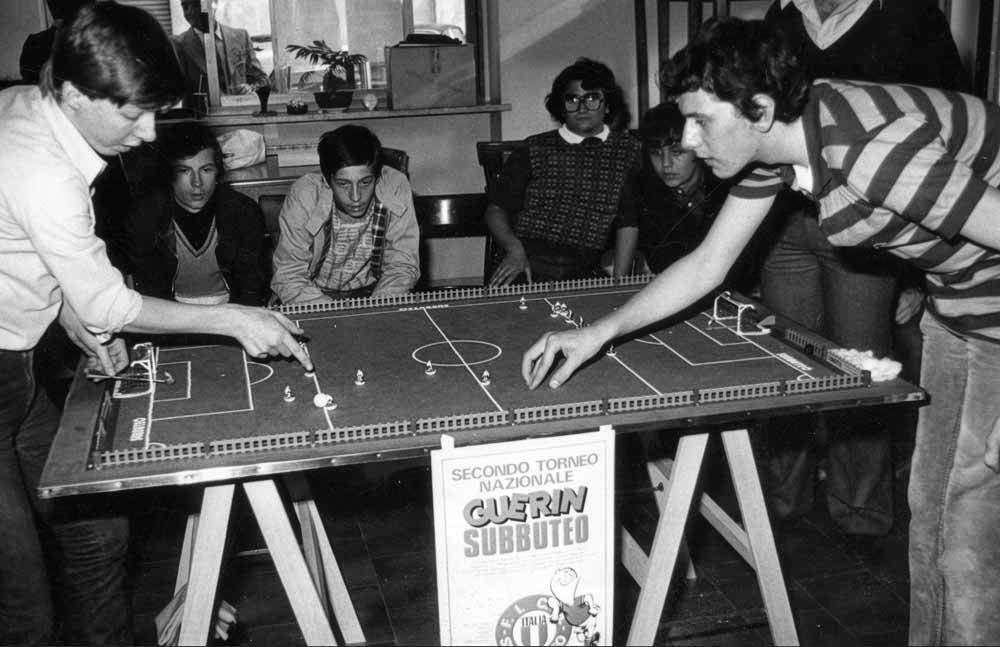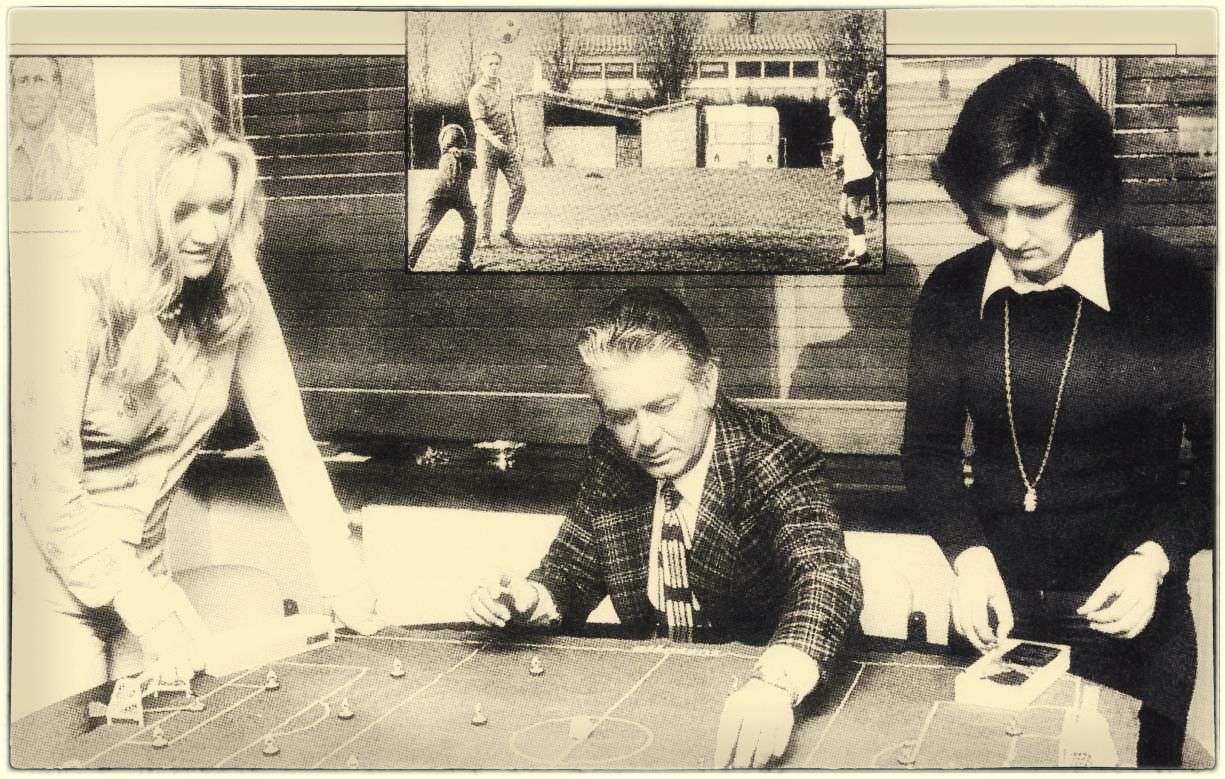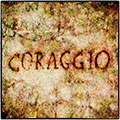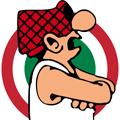-
MarcoIlVecchio.
User deleted
La volete quotare questa foto?? Così capiamo ance noi qualeeee...
Questa ! .
. -
.
Ma che Alberto Colli fosse stato un campione proprio non lo sapevo! . -
.
Bella carrellata di foto ed immagini,tanti miti del Subbuteo e del calcio vero...Baglietto,Piccaluga,Bruno Siciliano ai Mondiali del 74 contro Rietveld,mentre nella foto dei tiri piazzati riconosco...in piedi con la borsa Pierpaolo Pesce,grande giocatore Aquilano.
L'AICIMS nacque nell'estate del 1987...precisamente alla fine di quella estate,infatti quando giocai il Torneo Nazionale Città di Milano a Giugno,eravamo ancora tutti "sotto la stessa parrocchia".
Il 5 Settembre 1987 mi arrivò la prima circolare regionale "Targata AICIMS".... -
.Bella carrellata di foto ed immagini,tanti miti del Subbuteo e del calcio vero...Baglietto,Piccaluga,Bruno Siciliano ai Mondiali del 74 contro Rietveld,mentre nella foto dei tiri piazzati riconosco...in piedi con la borsa Pierpaolo Pesce,grande giocatore Aquilano.
L'AICIMS nacque nell'estate del 1987...precisamente alla fine di quella estate,infatti quando giocai il Torneo Nazionale Città di Milano a Giugno,eravamo ancora tutti "sotto la stessa parrocchia".
Il 5 Settembre 1987 mi arrivò la prima circolare regionale "Targata AICIMS"...
Ho corretto, guarda se ho capito giusto per favore!. -
.
Ok...estate 1987!!! . -
MarcoIlVecchio.
User deleted
Ma che Alberto Colli fosse stato un campione proprio non lo sapevo!
Bravino...
 .
. -
.CITAZIONE

Spettacolo Er Maestro! :-). -
.
Come da discorso fatto nella cronologia ecco due immagini dal 1975, l'anno in cui la Subbuteo provò ad accostarsi al circuito ETF.
Vedete come nei documenti ETF comparisse il nome "Subbuteo". La separazione definitiva avverrà nel 1977 (vedi sempre la cronologia).
. -
.
La "collaborazione" fini nel 1977 dopo il Meeting di Amsterdam,la Subbuteo e l'ETF si separarono completamente.
Il marchio Subbuteo non è mai stato comunque abbandonato,ecco una foto della locandina degli Europei 1989 giocati a Wallisellen!!! .
. -
.
Interessante, se così fosse dovremmo rivedere la netta separazione dei termini "Subbuteo" vs. "table football".
Però bisognerebbe esaminare il maggior numero di locandine e manifesti possibile per trarne una conclusione. Tu Vorbe quanto materiale hai?. -
Paolo_Torino.
User deleted
Incredibile.
C'è una foto delle finali regionali piemontesi del 1o Guerin Subbuteo tra Colli (a destra) ed il compianto Bodi (a sinistra).
Spettatore seduto in centro... mi pare di riconoscere un giovanissimo... mister.cairo !!!!
Era il secondo, c'è scritto anche nella foto. -
old england*.
User deleted
Povero bodi... . -
.Incredibile.
C'è una foto delle finali regionali piemontesi del 1o Guerin Subbuteo tra Colli (a destra) ed il compianto Bodi (a sinistra).
Spettatore seduto in centro... mi pare di riconoscere un giovanissimo... mister.cairo !!!!
Era il secondo, c'è scritto anche nella foto
(questo messaggio di Paolo_Torino è dell'utente paolocuccu che si è dimenticato di cambiare account). -
.
Qui c'è un'altra bella cronologia: www.gamingcorner.nl/subbuteo-timeline.htm
Tra l'altro ci sono anche notizie interessanti, come quella relativa al 1967 dove c'è scritto che le regole della English Table Soccer Association aveva regole diverse da quelle Subbuteo e permetteva materiali liberi
Subbuteo Timeline
1947
Peter Adolph creates his table football game, His game was a refinement and development of a previous table soccer game that had been first introduced in 1920. That game was called 'NewFooty'. The common principle of both games was that small figurines with semi-spherical bases that were slightly flattened on the bottom were flicked at a ball to propel it forward and eventually into the opponent's goal. The defender had a goalkeeper, which was a figure which had a rod attached to the back of the base, extending through the back of the goal, which allowed manipulation to save shots. The NewFooty figures were made of lacquered cardboard which were inserted into lead bases. This lead made them very hard to flick. Although similar in appearance to 'New Footy' Peter's plastic bases revolutionised table football.
The first game dates back to 1947 and consisted of a small cardboard box with a brown label on the lid that had a list of contents. These contents were: two cardboard sheets with the players printed on them, 20 small plastic bases for the field players and two rectangular bases for the goalies with metal rods for controlling them; two goals made of metal wire; and a stick of chalk for marking the pitch (which was not included in the box), which was an old army blanket that could be found in practically every home by the end of the Second World War.
1948
Subbuteo was born, Peter applied to register his game as 'The Hobby' after his favourite bird of prey - the Hobby Hawk. The application was rejected so Peter used the Latin name - Falco Subbuteo. The game was registered as Subbuteo and an icon was born.
1949
Press out cardboard figures introduced
Table Soccer Players Association formed, Players were encouraged to form leagues and affiliate them with Adolph's Table Soccer Players Association - TPSA.
Subbuteo table Cricket introduced, Cricket became the second most successful game produced by the company.
1950
Celluloid Figures. In this edition, the players were no longer printed on cardboard due to difficulties in cutting them out. These new figures were made of celluloid plastic (cellulose acetate). Although more expensive to buy, the new flat plastic figures promised to be 'scientifically designed to be 100% self balancing, and almost unbreakable'.
Accessories, The first accessories began to be created, such as a metal device for holding the goal in place, a material to make the ball stick to the net, flags, etc.
1951
Subbuteo Speedway introduced,This was reputed to be Peter Adolph's favourite game, although he did not invent it.
1953
3 versions of the game were designed, each with a different retail price. a popular assembly set, a combination set (plastic players) and a super set (pitch, assembled players and accessories all inside a beautiful box).
More Accessories, The variety of accessories continued to grow and a miniature referee’s whistle, game clock, scoreboard, etc. appeared.
Business expands, Two members join the now full time Peter Adolph.
Subbuteo Table Rugby introduced This game was not invented by Peter Adolph but sold under the Subbuteo name.
1955
Journey into Space, Inspired by the popularity of space travel and science fiction, a plastic spacecraft was propelled from a launch ramp towards a balloon planet.
1956
Subbuteo make their own bases, In 1956 Subbuteo began moulding their own bases using tools made by the Medway Tool Company in Paddock Wood.
Subbuteo Motor-Racing introduced, this game was similar to the Subbuteo Speedway.
1960
Peter Adolph bought the Medway Tool Company and could now manufacture his own bases.
1961
new Subbuteo figures, Moulded three dimensional plastic figures were introduced in 1961. George Erik modelled the '00' scale figures which were sold as the 'Continental Range'. The figures are painted and assembled by outworkers in Langton Green and Tunbridge Wells. These three dimensional plastic figures bases, which were larger, were divided into two parts, interior and exterior, which created the possibility of giving them different colours. The inside of the base was hollow, with a metal weight to give it some weight. The figure had a short-sleeve, V-neck shirt, with little detail and a strange posture and a flat appearance. The player was placed atop the top part of the base using a thin rod. This figure was produced until 1967, when it was replaced by the so-called “heavyweight” figure.
The game took off after this, as it was much easier to market it as an attractive 'realistic' soccer game. Literally every British schoolboy had a Subbuteo set. From there, SSG set out to conquer the world. Immigrants took the game around the globe, and then wherever soccer (football) was king, there was scope for Subbuteo to make inroads. In Italy it became very popular, and it strengthened in the low countries. In Malta it almost became the defacto national sport!
1963
Peter Adolph meets the Beatles, An opportune meeting in New York between the manager of the Beatles, Brian Epstein results in Subbuteo producing models of the Beatles.
1966
Subbuteo produced teams representing the sixteen nations competing in the world cup and advertised on the television for the first time.
1967
The English Table Soccer Association was formed this is an independent association from Subbuteo. It has its own rules and allowed members to customise their players.
1968
Waddingtons buy Subbuteo Games Ltd
1970
the “First International Table Football Tournament” took place in the Savoy Hotel in London. The prize was the John Waddington World Cup Trophy. The countries that participated were Belgium, Ireland, Gibraltar, Holland, Israel, Northern Ireland, Scotland, Switzerland, the USA, Wales, and the champion West Germany. the trophy was presented by Gordon Banks.
Peter Adolph resigns. After a troubled few years Peter resigned on 30 September 1970, ending 23 years association with the game.
The “heavyweight” figure was introduced, the figure had more detail and wore a long-sleeve shirt with a round neck. The designer of these figures was Charles Stadden and the figures were painted and assembled by housewives in Tunbridge Wells. This was the era in which Subbuteo could be said to have taken off, since the sets were sold in a very attractive package and could be found in toy shops and sporting goods shops all over the country.
Accessories continued to be developed, with rods for changing the goalie, medium-sized balls, specific figures for corner kicks and throw ins, and a much-anticipated accessory, the grandstand, which was sold with 5 spectators.
1971
Game of the Year Award, Subbuteo table soccer won the Game of the Year Award at the British International Toy Fair in Brighton
Throughout the evolution of the game, press-out cardboard and celluloid figures had still been available to buy. They finally disappeared from production.
1974
Both the FIFA and the Subbuteo World Cups took place in Munich where Holland was the winner, Subbuteo launched a special Munich World Cup Edition.
There were 1.5 million Subbuteo players worldwide.
1975
Snooker Express was launched by Subbuteo. The box states that billiards, snooker, pyramids and pool could be played. So it is basically snooker except you use a flicked Subbuteo Snooker player instead of a cue.
1976
The figure known as the “Zombie” was born because Subbuteo Sports Games needed a figure that could be assembled and painted by a machine, the figures had been hand painted by outworkers since the early 1960s. The figure was very simple and lacked distinguishing features, and this is the origin of the popular way of referring to the figures as zombies. Although they were created by machines, hand-painted zombie figures could also be found. Both versions of sets were available. These were the first figures to be exported to Greece. This figure did not have much success.
1981
The figure known as “lightweight” was created; it is a more detailed figure, with bent knees (similar to the “heavyweight” figure) but more thinner and with a lighter design. They were machine painted, although during the first two years of production they were also hand painted. These figures’ details allowed for logos, crests, and stripes. This figure was used from 1981 until 2000.
Among the accessories created during this period were crowd barriers, mounted police and a hockey set This game was available from 1980 to 1983 and was designed to target the female market. This didn't really work and the set was a poor seller. Also the Hockey sticks were very easily broken
Now that production was no longer reliant on outworkers, there was no reason to keep Subbuteo in the Tunbridge Wells area. In 1981 Waddingtons moved production to Washington, Tyne and Wear and after 6 months to Leeds.
1982
Number of players soars, 7 million people worldwide were playing Subbuteo in 50 different countries.
Subbuteo Indoor was released, It was introduced as a late replacement for Football Express (5 a side) and also in an attempt to capture the American market.
1983
From 1983 to 1987, Waddington progressively reduced Subbuteo’s product range (by removing its cricket, rugby, and hockey games from the market), and they also reduced the number of teams available (from 298 to 169) and the number of sets.
1987
Waddington decided to relaunch its new line of Subbuteo products and to target a new audience. Among the game’s new accessories were a new grandstand, now red and blue, and the grey corner piece
Waddington chose to acquire new licences, starting with those of the 1990 World Cup in Italy and the 1994 World Cup in the USA.
1988
2 years after the band 'Half man Half Biscuit' released their Subbuteo song 'All I want for Christmas is a Dukla Prague Away kit' the BBC produced a 6-part drama about a fictitious Subbuteo team - Real Falkirk.
1989
As popular as ever, Subbuteo won the Toy of the Year award in 1989.
1990
The Britisch Channel 4 covered the Subbuteo World Cup in Rome.
1991
The modern stadium was complete with the arrival of “Greek pillar” floodlights.
1992
Another firm began manufacturing table soccer figurines for use in the game. These 'Sports' figures did not infringe any Subbuteo copyright and were quickly recognised by players as first class equipment. The company had approached Willy Hofmann to help design them.
1994
At this time, every team produced automatically had 3 black players to at reflect changes in real football.
The American Games manufacturer Hasbro bought Waddingtons Ltd. Now the game of Subbuteo was just one of a family of games that included Monopoly and Cluedo.
Hasbro made a number of changes, It began with a key change to the base of the figures. They were now just one piece and one colour, apparently solid and without the metal weight, with a larger bottom and a thinner curved edge. This increased the figure’s stability and made straight movements much easier.
1995
Hasbro acquired the 1996 Euro and 1998 World Cup licences.
1997
The official Manchester United Edition was released with new accessories and also included the club’s crest on the centre circle of the pitch and on the balls. The new “Club” set even came with a surprise: the pitch was made of a new material – not as good as the baize from the 1970s, but better than nylon. It was a shame it only appeared in this set.
1998
The first new set from Hasbro is released for the World Cup with new style throw-in and corner-kick figures.
2000
Hasbro launched new sets that were a relaunch of the sets with the Premier clubs, an updated version of the Manchester United Edition, and a deluxe set that included the return of the grandstand (this time in red and white) and three teams.
After several years of declining sales, Hasbro announced that they would no longer be producing Subbuteo. Due to an outcry from the public Subbuteo was saved, but was only sold in Toys R Us and only 10 teams were available.
2001
The word was that Hasbro were finally ceasing production of all of the Subbuteo range. Their reason was quite simply that they were not selling enough sets of the game to warrant continuing to manufacture them.
Almost at once negotiations started between the interested parties to either buy the name "Subbuteo" from Hasbro or to buy a licence to manufacture using the name.
2002
In 2002 the licence to produce Subbuteo was given to the Perodi family in Italy. Perodi, who had been producing their own version of table football for years made some changes, a new playing figure, a redesigned base more suitable to the modern game, the return of the Astropitch, etc.). The teams were painted in China. The family held the licence until December 2005.
2005
Hasbro re-launched Subbuteo table football in March 2005. Branded as 'a 21st century version for a new generation', the game has a stadium pitch. The new players are printed flat plastic, strangely reminiscent of the very first players, now 60 years old.
2006
Release of Subbuteo Urban Arena. This is fast paced, 5-a-side football at its best. Customise your arena and show off with outrageous tricks using flat plastic players from Europe's finest clubs
After this edition, Subbuteo disappeared from shops.
2009
A special edition under Hasbro’s licence was launched in England by Marc & Spencer and was quite successful.
2012
After several years of not being available in shops, a new Subbuteo game reappears with full force in 2012. The product follows this idea, respecting Subbuteo’s classic identity while adding new features that improve the game considerably.
Some of these features that did change were a new base design that improves stability and makes movement easier. More detailed figures: Teams have players of different races, with long and short hair, blonde/brown/red hair, different-coloured football boots, etc. and figures are made with a more flexible and durable material that resists breakage.
It’s been many years of waiting, but Subbuteo has returned… this time to stay…. -
.
Azz...!!!  .
.

